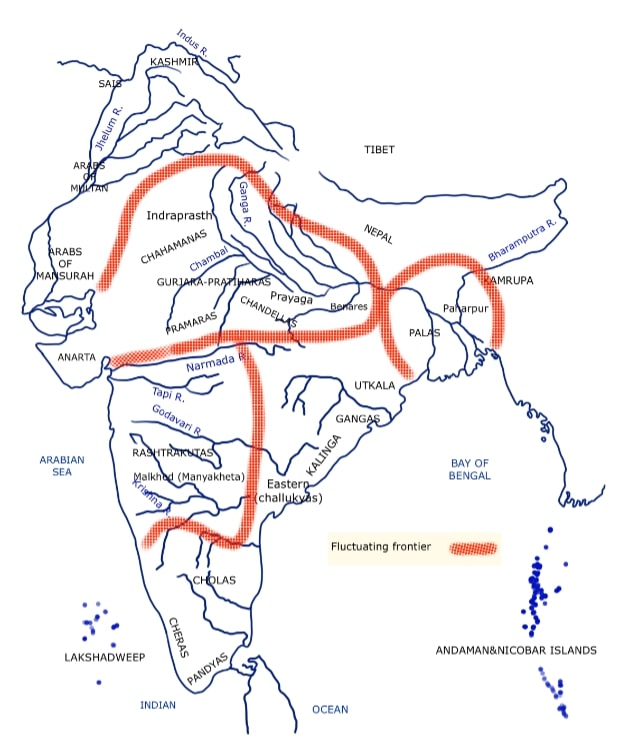Soon after the downfall of the Mauryan empire, the Guptas emerged as the rulers and built their legacy in the country. After the decline of the Gupta dynasty, numerous smaller kingdoms came to power. The Vardhana dynasty began ruling Thaneshwar. The most famous king of the Vardhana Dynasty was King Harshavardhana. The Satavahana, Chalukya, and Pallava dynasties also started emerging. All these South Indian kingdoms were organized and managed well. This period saw many changes in the administration system and the management of the armies. Art and architecture also flourished under the rulers of this era.

New Kings and Kingdoms
The most significant ruling dynasties were the Pallavas and Chalukyas during this time. The Pallavas ruled the areas around Kanchipuram and were spread across the Kaveri delta. The Chalukyas ruled the areas between the rivers Tungabhadra and Krishna. The capital city of the Chalukyas was located at Aihole.
The Pallavas and Chalukyas promoted the construction and establishment of some temples that are famous in the present day. During this era, art and architecture thrived under the rule of the Chalukyas and Pallavas. The prashastis that were written during this era by Ravikirti, the court poet of the most famous Chalukya ruler, Pulakesin II, tell us about the expeditions that were undertaken by the ruler to explore the eastern and western coasts.

Samantas emerging as Kings
Similar to the previous dynasties, the rulers of the newer and emerging kingdoms also had a well-organized and well-maintained army. The army consisted of elephants, cavalry, chariots, and foot soldiers.
The king appointed military leaders to provide an army whenever required. Instead of being paid a fixed amount of money like a salary, they were given grants of land. The military leaders collected taxes from the land and used it to cover the expenses incurred to maintain the army, the warfare equipment, the elephants, horses, and foot soldiers.
Whenever the ruler was in a weak state, the Samanthas would try to take control of the kingdom with the army at their disposal. In this way, many small kingdoms came into being across various parts of the country.
Revenue Resources
Land revenue was one of the revenue resources. The basic unit of administration was the village. However, during this period, many changes in the administration of the kingdom took place. The kings were no longer the total authority. They took many steps to favour the powerful men in the kingdom. These men were either rich, had a good network of people, were politically strong, or had access to the army. The kings did so to prevent these men from taking over the throne or creating their own kingdom.
The kings also began making some of the administrative posts hereditary so that the post holder would be faithful to the king. One person would strategically hold many posts in various offices. This would make it easy for them to keep track of the happenings in all places so that the king could be alerted if anything was being planned against him. The influential men in the kingdom had a say in the kingdom’s administration. The ruler would rather let them share their opinions rather than have them do something more drastic such as planning to take over his kingdom.
Prashastis
Prashasthi is a Sanskrit word that translates to ‘in praise of’. During this period, many travellers visited India. They wrote lengthy accounts of what they saw. They even wrote poems that praised the king. The poems were inscribed on pillars and were located in various places around the kingdom. It gave information about wars that were fought, the policies of the king, and the account of daily life. Some of the Prashastis also had genealogical information about the previous kings and their relation to the present king. There were also descriptions about how the empire was built and the other activities that were undertaken by the king to improve the lives of the masses.
Land Grants
The land was granted to the people who held powerful and important posts in the administration.
The king granted chunks of land instead of salaries. The landowners collected revenue generated by the lands. It is essential to note that the Samanthas were granted lands instead of fixed salaries. The Samanthas were the military heads who were the sole authority of the army. They collected the revenue that they got from the land and used it to improve and strengthen the army. Land grants were also given to scholars and priests.
Conclusion
Several changes occurred during this era which gave rise to various kingdoms and rulers. The quality of life of the people improved, the armies became stronger, and the kings became wary of those trying to take over their kingdom. New empires were also being established during this era. Soon after the fall of the Chalukyas and Pallavas, new empires of the Chola and Rashtrakuta dynasties were established.
 Profile
Profile Settings
Settings Refer your friends
Refer your friends Sign out
Sign out













